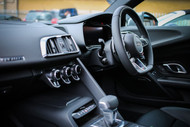Electric vs. Hydraulic Steering: Key Differences Explained
10th Feb 2023

Do you know the difference between electric and hydraulic power steering? While once viewed as a luxury, power steering has since become a core feature in nearly all modern vehicles. Whether you drive a car, truck or SUV, it probably has power steering. But not all power steering technologies are the same. There's electric power steering, and there's hydraulic power steering.
What Is Hydraulic Power Steering?
Hydraulic power steering is the oldest and, thus, the most common power steering technology. As the name suggests, it involves the use of hydraulic fluid. Hydraulic power steering systems have a pump that pulls hydraulic fluid from a reservoir. As the hydraulic fluid enters the power steering system, it assists the driver with steering. You can essentially turn the steering wheel more easily once the hydraulic fluid has found its way into the power steering system.
What Is Electric Power Steering?
Electric power steering is a newer technology. Like hydraulic power steering, it's designed to assist the driver with steering. All power steering systems make reduce the amount of force needed to turn the steering wheel -- and electric power steering is no exception. But electric power steering uses an electric motor to perform this task. If your vehicle has an electric power steering system, it will use an electric motor to help you turn the steering wheel.
Differences Between Hydraulic and Electric Power Steering
Most power steering systems fall under one of two categories: hydraulic or electric. In the past, it was the only power steering technology. The first vehicles that offered power steering used a hydraulic-power system. Automakers, however, now offer electric power steering as an alternative.
While they both assist the driver with steering, hydraulic and electric power steering are different technologies. Hydraulic power steering relies on hydraulic fluid to assist the driver with steering. Also known simply as power steering fluid, it will flow through the rack and pinion. A pump will pull the hydraulic fluid from a reservoir, and while under pressure, the pump will transfer it to the rack and pinion.
Electric power steering systems don't have any hydraulic fluid, nor do they contain a reservoir or pump. Instead, they rely on an electric motor to assist the driver with steering. Vehicles with electric power steering feature a motor connected to the steering rack or column. When you turn the steering wheel, an array of sensors will send data to this motor. The sensors will essentially tell the motor how to respond.

